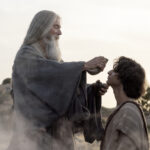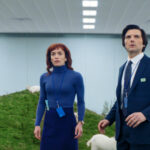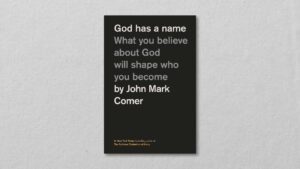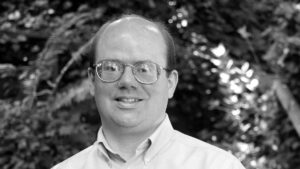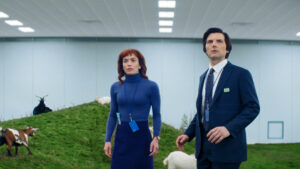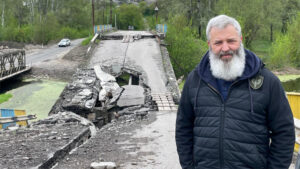The title of Terrence Malick’s A Hidden Life comes from a line in George Eliot’s Middlemarch: “The growing good of the world is partly dependent on unhistoric acts; and that things are not so ill with you and me as they might have been, is half owing to the number who lived faithfully a hidden life, and rest in unvisited tombs.”
The title is apt for this subject’s story. Franz Jägerstätter is probably not a familiar name to you. An Austrian farmer and devout Catholic, Jägerstätter’s faith led him to defy the Nazi regime during World War II, refusing to swear allegiance to Hitler. His unheralded and largely unremembered act of defiance—which led to his imprisonment and execution in 1943—made little sense to most people in his small Alpine village, St. Radegund. And while his story shares similarities to that of Dietrich Bonhoeffer (whose time in Berlin’s Tegel prison overlapped a bit with Jägerstätter’s), it’s far less known.
But as much as Malick’s film (in theaters this Friday) shines a compelling spotlight on Jägerstätter’s humble, heroic, “hidden” life, it’s even more about another “hidden” life: God. It’s a film about the challenge of steadfast faith when the one we believe in feels unseen and absent. Hebrews 11:1 is pithy and familiar—“faith is the assurance of things hoped for, the conviction of things not seen”—but it’s hard to live out.
By leaning into the honest difficulty of belief, and yet clinging to hope, Malick’s A Hidden Life becomes more than just a cinematic masterpiece. It’s also a bracing apologetic for true Christian faith. As biblically inspired as any other film in recent memory (probably since Malick’s own Tree of Life in 2011—the best Christian film ever made), A Hidden Life is a psalm crying out to the God of refuge and deliverance. It’s also a cinematic sermon on the mount, envisioning the upside-down kingdom of God from a literal mountaintop (Matthew’s Gospel figures prominently). But perhaps most of all, the film is an epistle-esque prison letter of encouragement to any struggling saint whose humble prayer is, Lord, I believe. Help my unbelief.
When Christ Calls a Man
Malick’s A Hidden Life is a film in conversation with Martin Scorsese’s Silence. When Malick saw Silence, he apparently wrote Scorsese a letter in which he asked, “What does Christ want from us?” Both Silence and A Hidden Life are interested in this question. Both are about Christians who endure persecution and are willing to suffer greatly rather than betray the name of Christ. In both films, many people try to convince the Christian protagonist that faith doesn’t require such sacrifice, that choosing death over apostatizing is foolish and unnecessary. As one clergyman tells Jägerstätter (August Diehl) in Life, “God doesn’t care what you say; only what’s in your heart.” That perspective is more or less where Silence lands on the question. But Malick isn’t satisfied with that answer. His film resonates more with Bonhoeffer’s famous statement, in The Cost of Discipleship: “When Christ calls a man, he bids him come and die.”
Malick’s film, like Bonhoeffer’s book, confronts the scourge of casual, comfortable Christianity where “cheap grace” prevails and discipleship is consumer-friendly. Malick seems to agree with Franz, who wrote in one of his prison journals: “Nominal Christians do the most harm to the church.” The film’s conflict is between true, costly faith—represented by Jägerstätter and his remarkably steadfast wife, Fanni (Valerie Pachner)—and nominal, comfortable faith (represented by almost all the other “Christians” in the film, including clergy). When Franz asks a bishop (Mikael Nyqvist), “If our leaders are evil, what does one do?” the bishop responds, “You have a duty to the fatherland” and cites Romans 13:1–2. This is the refrain Franz hears from Christians: get off your high horse and fall in line. Honor the emperor! Don’t betray your nation! But Franz doesn’t buy it, insisting one’s identity in Christ should trump all earthly allegiances. “We’ve forgotten our true Fatherland,” he says.
Malick’s film confronts the scourge of casual, comfortable Christianity where ‘cheap grace’ prevails and discipleship is consumer-friendly.
His stubborn conviction looks like madness to most of his friends, and indeed it is—true Christian faith is always folly in the eyes of the world. “To follow him is insanity,” one character says. Christianity is costly. In a pivotal scene, Franz chats with a painter (a sort of stand-in for Malick himself) who talks about the difference between followers and admirers of Christ. “I paint their comfortable Christ,” he says of the “admirer” Christians. “Someday I’ll paint the true Christ.” One way to read A Hidden Life is to see it as Malick’s attempt to paint “the true Christ,” at least in an allegorical sense: the Christ whom Peter rebuked for even suggesting he must die (Matt. 16:22); the Christ whose atoning sacrifice Nietzsche called “deranged.”
To the Cross
Music is always vital and never random in Malick films. The choice of Bach’s “St. Matthew’s Passion” to open the film, then, is an interpretive key. Bach’s masterful oratorio is arguably the definitive work of sacred music about Christ’s journey to the cross. Malick’s A Hidden Life aspires to a similar place—it’s a work of sacred cinema about Christ, his sacrifice, and the cross-shaped lives of his followers.
It’s hard to miss the echoes of Christ in Malick’s telling of Jägerstätter’s story. Early in the film, Franz stops on a road and looks directly at a statue of Christ on the cross, as if he knows his path is headed in that direction. For much of the film, Franz spars with Austria’s version of scribes and Pharisees—the religious authorities who come to revile Franz for his seeming arrogance and dangerous zealotry. “Your sacrifice will benefit no one” is their refrain, as one friend after another abandons Franz to his delusional, embarrassing cause. Malick underscores the Christ parallels by inserting a few “wilderness temptation” scenes when Franz is hungry, cold, and lonely in prison. A devilish man in a nice suit (Matthias Schoenaerts), bathed in cigarette smoke, tries to undermine Franz’s faith (“Are you really innocent? We all have blood on our hands.”). Another scene echoes Christ before Pilate when a judge (played by the great German actor Bruno Ganz), who is unsettled about condemning Franz, asks him: “Do you judge me?” Finally, when Franz is moments away from execution, he shares a tender moment with a “thief on the cross” character, a frightened fellow criminal awaiting execution.
Malick wants us to contemplate Christ as we witness the martyrdom of Franz. But this isn’t just the story of Franz. It’s also the story of Fanni, his faithful and long-suffering wife. It’s in Fanni’s story—of trusting, waiting, suffering, but with hope—that we find our story, the bride of Christ.
It’s in Fanni’s story—of trusting, waiting, suffering, but with hope—that we find our story, the bride of Christ.
Bride and the Bridegroom
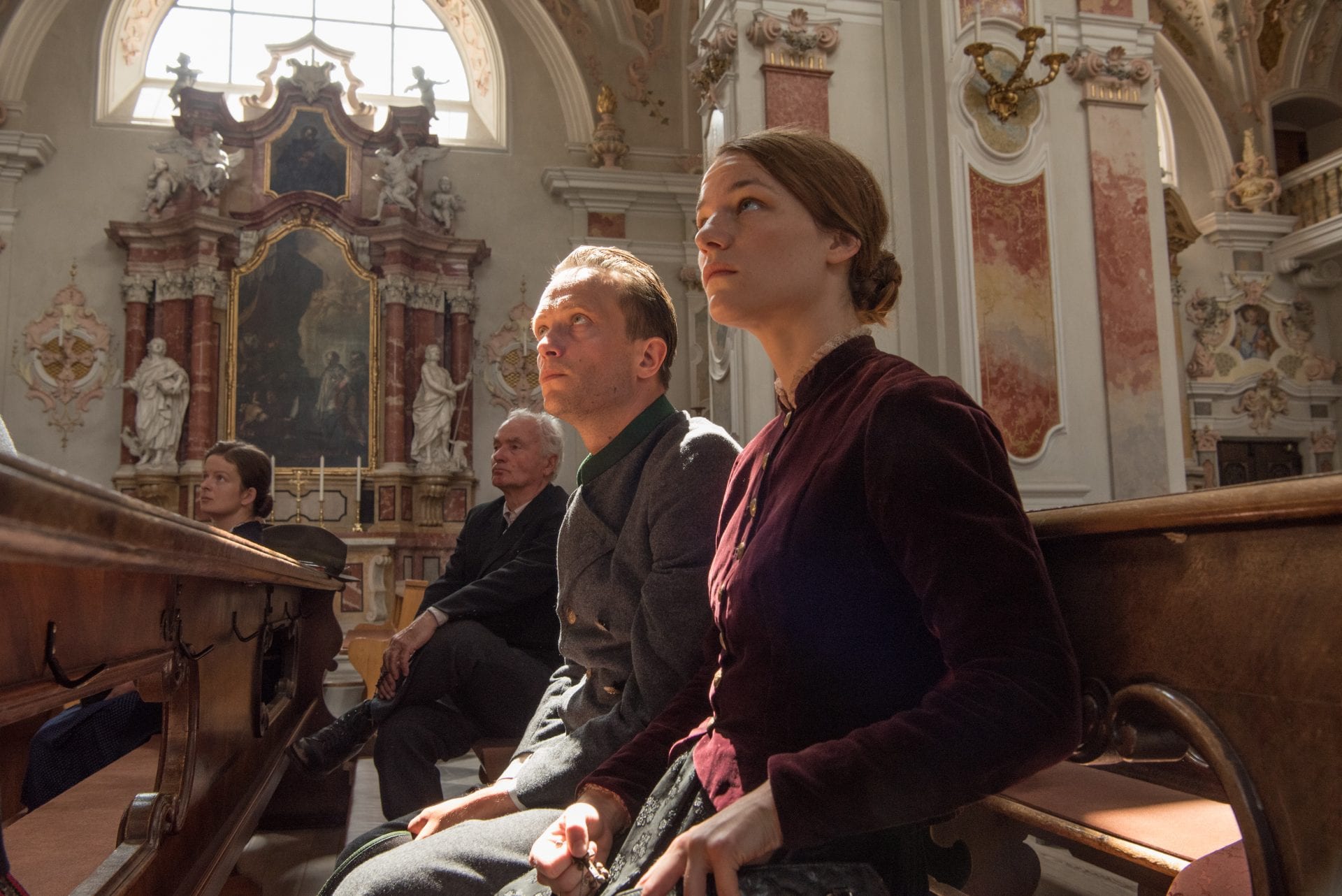
Perhaps the central shot of A Hidden Life is an image of Franz and Fanni’s hands, clasped together in the air—their wedding rings prominent. The film is a marriage story. It’s about the struggle of fidelity amid hardship, love amid distance—for Fanni and Franz, and for the church and her groom, Christ.
Early in the film, Fanni remembers the moment she met Franz. But as much as it’s a memory it is also an eschatological vision of reunion. “I was wearing my best dress,” Fanni says, echoing Revelation 19:7–8 (“his bride has made herself ready; it was granted her to clothe herself with fine linen, bright and pure”). And Franz rode into the valley on a motorcycle—like the return of Christ on a white horse (Rev. 19:11). It’s a beautiful, Edenic moment that bookends the film—union before it was broken, then union restored. But in between there is struggle.
Fanni’s covenant union with Franz means she shares in what’s his, both the good and the bad. His triumph is hers, but so is his tragedy. She shares in her husband’s suffering, just as we share in Christ’s (1 Pet. 4:13). She is ridiculed, ostracized, even spat upon for her husband’s sake. She remains faithful and never betrays him, but it isn’t easy. At home in St. Radegund she must keep her farm and family going, caring for her three young daughters, her sister, and her elderly mother-in-law. She struggles in the field, her hand to the plow. She tends to the sheep, even though the better shepherd (Franz) is not there to help. She feels exhausted and alone. Where is Franz? Where is God? They are hidden. But she trusts and loves them in their absence. Fanni’s faith is the film’s beating heart. At times it is weak (she tells Franz: “You can’t change the world. The world’s stronger.”). She prays to God (similar to Mrs. O’Brien in Malick’s Tree of Life): “Lord, you do nothing. Where are you? Why did you create us?” But mostly Fanni is steadfast, even as she prays to a God who seems uncaring and writes letters to a husband who seemingly abandoned her for a suicidal conviction. For all her troubles, she still finds time to visit and care for the widows in her village.
Widows are central in the film, and widowhood is Fanni’s future. Widows, of course, are also important in the Bible. Perhaps God has such a heart for widows because he knows their predicament—a vulnerable, grieving wife who misses and longs for her husband’s presence—is close to the predicament of his own bride, the church, in the “already, not yet” space before our Revelation 19 reunion.
Body and the Head
A widow’s life, cut off from her husband, can feel like having part of your body removed. This is part of why Paul in Ephesians 5 compares a marriage to a body (wife) and a head (husband)—emphasizing the importance of union and the violence of whatever in life (divorce, death) would sever the bond. This marriage union is a mystery that points to Christ (the head) and his union with the church (the body).
As the real Franz Jägerstätter wrote in his prison journals (which the film often quotes) shortly before his execution, “A husband is a reflection of Christ, the Savior, whose body is the church. A wife is a reflection of the church, the bride of Christ, who Christ has loved to full self-giving.”
Decapitation figures prominently in the film—Franz is executed by guillotine, just like Sophie and Hans Scholl, and other Christian martyrs in World War II. It’s a historical reality but also a metaphor for Fanni’s struggle, and ours: being the church can often feel like walking around headless. The Holy Spirit is in us, and we know our union with Christ is real. But our lived experience—our struggle to feel God’s presence—can seem like we too have been guillotined.
But there is hope. My favorite moment in A Hidden Life is a dream-like monologue from a fellow prisoner and friend of Franz’s named Waldlan (Franz Rogowski in a small but memorable role). In semi-macabre fashion he envisions the decapitation moment when the head is separated from the body. But as it falls, what if you caught it with your own hands before it hit the floor, and then put it back on your head? And as you do it you notice your hands are no longer in chains. Your head and body are reunited. You are whole again, and free.
The film is a marriage story. It’s about the struggle of fidelity amid hardship, love amid distance—for Fanni and Franz, and for the church and her groom, Christ.
Look to the Hills
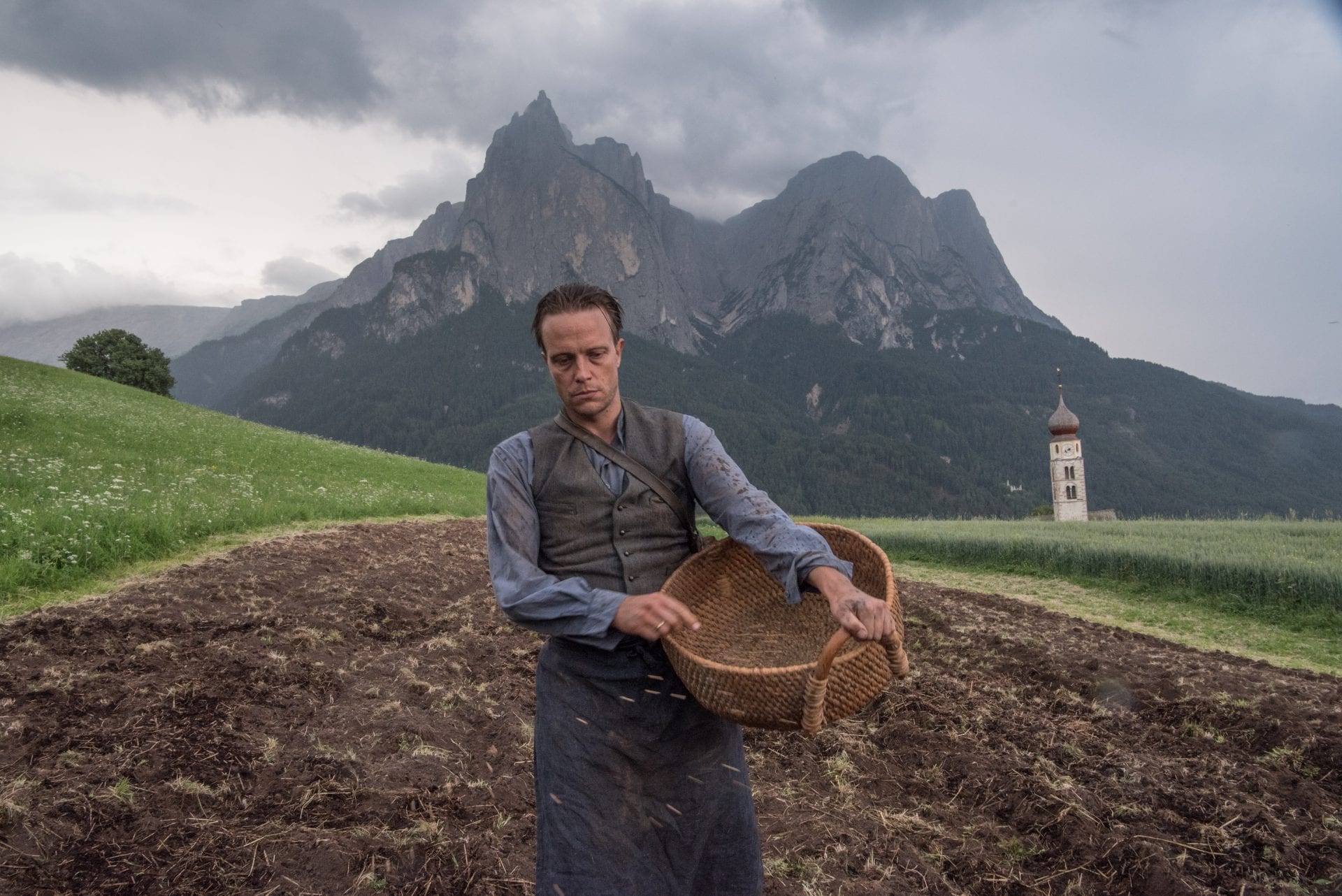
Profound eschatological longing runs through A Hidden Life as powerfully as the Salzach River (a frequent image in the film). It takes various forms—an ache of a bride for her bridegroom, a body’s longing for a head. We also see it in the film’s focus on mountains, a constant upward gaze. The opening line evokes this: “I thought we could build our nest high up, in the trees, fly away like birds to the mountains.” It’s Franz speaking, in voiceover, of his longing to live above the dark clouds of sin, death, and war. The film’s final line returns to the motif, this time with Fanni: “Franz, I’ll meet you there—in the mountains.”
As well as a Gospel of Matthew-inspired “sermon on the mount” (literally), the film feels like a “song of ascents” in the manner of Psalm 121:1-3:
I lift up my eyes to the hills. From where does my help come? My help comes from the LORD, who made heaven and earth. He will not let your foot be moved.
Fanni and Franz are living on unsteady ground in more ways than one. Everyone around them wavers—their feet are being moved. The gravity of the mob, of comfortable faith, pulls them down. Cinematographer Jörg Widmer captures this by showcasing wobbly shots of Franz and Fanni struggling against the gravitational pull of the steep, literally slippery Alpine slopes. The visual ambience of the film revolves around verticality: the tension between ground and the sky, valleys and mountains, earth and heaven.
In their struggles and pain, Fanni and Franz look often to the hills, the grand peaks that put their lives in perspective. God is bigger. There is more to this world. Psalm 144 is their cry. Franz literally quotes verse 4 (“Man is like a breath; his days are like a passing shadow.”), but verses 5–6 are visually evoked: “Bow your heavens, O LORD, and come down! Touch the mountains so that they smoke! Flash forth the lightning and scatter them. . .” God may seem “hidden” in the film, but he is there. The mountains smoke. There is lightning.
God’s creation gives Fanni and Franz comfort and hope. “Nature does not notice the sorrow that comes over the people,” Franz says. Blackbirds keep singing. Spring comes again. When all else seems silent, Fanni hears God in creation: “The new hay gives me hope, the wind, the wheat, the sky.”
But they also take comfort in Scripture. It’s interesting that for Fanni and Franz, all that they have of each other in the end is a few letters. They would of course want more, but they at least have this. Blessed written words. In one of his final letters, written in red crayon in prison, weeks before he was executed, Franz observed, “All that is earthly—no matter how much, nor how beautiful—comes to an end. But God’s Word is eternal.”
Indeed. Creation too will one day crumble. The mountains erode. The grass withers. The flower fades. But the Word of our God will stand forever.
Creation will one day crumble. The mountains erode. The grass withers. The flower fades. But the word of our God will stand forever.
Time Will Come
When it comes to Christian faith, the struggle is real. That much is clear in Malick’s epic cinematic epistle.
The inertia of sin, like the gravity of the slippery slopes pulling us down the mountain—it’s real.
The doubts and conundrums that plague our minds—they are sensible.
The toil and hardship of earth-bound existence—it’s brutal.
“Look to the hills” is a pretty slogan, but what happens when the help doesn’t come? Sometimes it doesn’t. Sometimes God feels like a hidden life. The world’s senseless suffering and evil troubles the soul. It feels like insanity to keep believing. You can understand the loss of faith apparent on the bishop’s resigned face when he tells Franz: “You hear those bells? They are melting them for bullets.”
But while the bells become bullets now, one day the swords will be plowshares (Isa. 2:4). And this is the hope Fanni clings to: “The time will come when we will know what this is all for. . . . We’ll work together. We’ll plant orchards, fields. We’ll build the land back.”
New creation is coming, but for now we groan, along with all things (Rom. 8:22–23). Like Fanni, we keep sowing seeds and harvesting in the field; we keep feeding the sheep. And we wait with eager expectation for that long-sought reunion, and eternal communion, with the one who will be hidden no more.
“The Most Practical and Engaging Book on Christian Living Apart from the Bible”
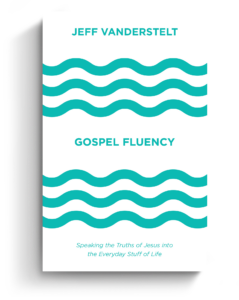 “If you’re going to read just one book on Christian living and how the gospel can be applied in your life, let this be your book.”—Elisa dos Santos, Amazon reviewer.
“If you’re going to read just one book on Christian living and how the gospel can be applied in your life, let this be your book.”—Elisa dos Santos, Amazon reviewer.
In this book, seasoned church planter Jeff Vanderstelt argues that you need to become “gospel fluent”—to think about your life through the truth of the gospel and rehearse it to yourself and others.
We’re delighted to offer the Gospel Fluency: Speaking the Truths of Jesus into the Everyday Stuff of Life ebook (Crossway) to you for FREE today. Click this link to get instant access to a resource that will help you apply the gospel more confidently to every area of your life.










